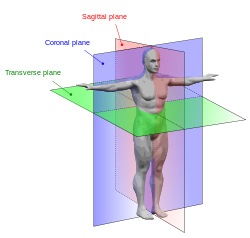- Sagittal plane
-
Sagittal plane 
Diagram showing sagittal, coronal and transverse planes. Latin plana sagittalia Sagittal plane is a vertical plane which passes from front to rear dividing the body into right and left sections.
Contents
Variations
Examples include:
- The terms median plane or mid-sagittal plane are sometimes used to describe the sagittal plane running through the midline. This plane cuts the body into halves (assuming bilateral symmetry),[1] passing through midline structures such as the navel and spine. It is one of the lines defining the right upper quadrant of the human abdomen.
- It is also worth mentioning that terms such as parasagittal are sometimes used to describe a plane parallel to the midline; however, this term is unnecessary, since any plane parallel to and on either side of the medial plane is sagittal by definition.
- In general, planes that are parallel to the sagittal plane, but do not pass through the midline, are known as parasagittal.
- The midclavicular line crosses through the clavicle.
- Other sagittal lines/planes include the lateral sternal and parasternal.[2]
Terminology
The term sagittal is derived from the Latin word Sagitta, meaning "arrow". An image of an arrow piercing a body and passing from front (anterior) to back (posterior) on a parabolic trajectory would be one way to demonstrate the derivation of the term. Another explanation would be the notching of the sagittal suture posteriorly by the lambdoidal suture —similar to feathers on an arrow.
- Sagittal axis is the axis perpendicular to the sagittal plane, i.e., the sagittal axis is formed by the intersection of the coronal and the transversal planes.
- Abduction and adduction are terms for movements of limbs relative to the coronal plane.
- Coronal axis or frontal axis is the axis perpendicular to the coronal plane, i.e., the one formed by the intersection of the sagittal and the transversal planes. Extension and flexion are the movements of limbs relative to the sagittal plane.
See also
References
- ^ "Median plane" at Dorland's Medical Dictionary
- ^ Yokochi, Chihiro; Rohen, Johannes W.. Color Atlas of Anatomy: A Photographic Study of the Human Body. Hagerstown, MD: Lippincott Williams & Wilkins. pp. 2006. 217 p.. ISBN 0-7817-9013-1.
Anatomical planes and lines (TA A01.2.00, GA 12.1309) Sagittal plane front (Anterior median line/Midsternal line, Parasternal line, Midclavicular line, Anterior axillary line, Midaxillary line)
back (Posterior median line, Scapular line, Posterior axillary line)Transverse plane Thoracic plane · Transpyloric plane · Subcostal plane · Umbilical plane · Intertubercular plane · Interspinous plane · uterine plane · enterocolicosigmoid planeCoronal/frontal plane General anatomy: systems and organs, regional anatomy, planes and lines, superficial axial anatomy, superficial anatomy of limbs 
This anatomy article is a stub. You can help Wikipedia by expanding it.
